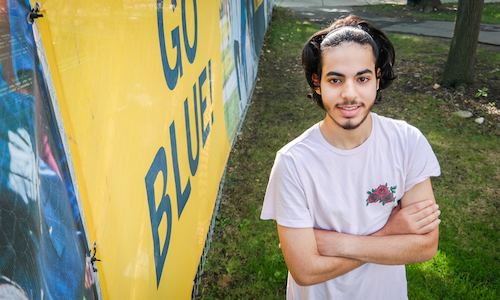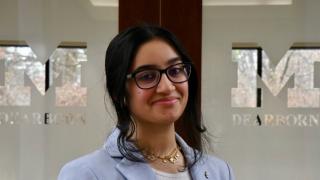Hassan Ibrahim says he has a habit of quizzing his professors about their research specialties, and most of them are happy to oblige the sophomore’s earnest curiosity. Last semester, in fact, one such after-class conversation led to an unexpected opportunity. He was chatting with Jie Shen, picking the veteran computer and information science professor’s brain about his dissertation research. It was a short conversation, as Ibrahim recalls, but a few weeks later, Shen asked him if they could talk after class.
“I honestly thought I was in trouble,” Ibrahim says, laughing. “But he was, like, ‘Hey, I have this research opportunity coming up in a couple months, are you interested?’ And I said, ‘Yes, definitely.’ I didn’t even know what it was for. But I knew Shen was doing so much cool stuff. So I thought, why not?”
Turns out, the opportunity Shen had in mind was a spot on his virtual engineering lab team, which in addition to some other really fascinating projects, is developing a virtual environment for testing autonomous vehicles. It’s a super leading-edge field in the automotive industry, but one that also packs a lot of promise. Currently, field testing is the main way of verifying the performance of autonomous vehicles. But because testing on public roads filled with human drivers presents certain legal and safety issues, many companies have had to build elaborate testing campuses. (The University of Michigan’s MCity is a premier example.) It’s an expensive and time-consuming way to test — and even then, it’s still difficult for researchers to recreate everything a car is likely to encounter on public roads.
So Shen and his team are investigating whether virtual environments could be a good compliment to field testing. It’s still early days for their research, but the simulator Ibrahim showed off for us this week gives you an idea of how it would work. Resembling a racing video game, several virtual test cars navigate a winding track. On their first try, the cars miss turns and bump into walls. But as the simulation continues, the cars get “smarter.” They learn from their mistakes, and after 20 or so iterations, they’re able to cruise the entire course without a problem.
Ibrahim says such simulations could help determine whether machine learning-based testing environments could be a useful tool for improving the algorithms that power autonomous vehicles. That method, when fully developed, could also have some big advantages over field testing. Most importantly, because computers can run thousands of simulations in practically no time at all, they could draw faster conclusions about, say, the efficacy of a particular vehicle control strategy. And more sophisticated simulations could accommodate dozens of variables — like snow, fog or interaction with pedestrians — which can be challenging to test in the real world. Virtual testing is also a lot cheaper.
The experience has hooked Ibrahim on research, and he’s hoping to start the next phase of his work with Shen later this month. What he’d really like to do, though, is find a project that digs into autonomous vehicles’ cybersecurity issues. Not surprisingly, he says he’s already begun chatting up our many UM-Dearborn faculty who are specialists in that.
###
Hassan Ibrahim’s student research was funded through UM-Dearborn’s Summer Undergraduate Research Experience (SURE) program and won the “Most Intriguing” award at this year’s SURE research slam.





